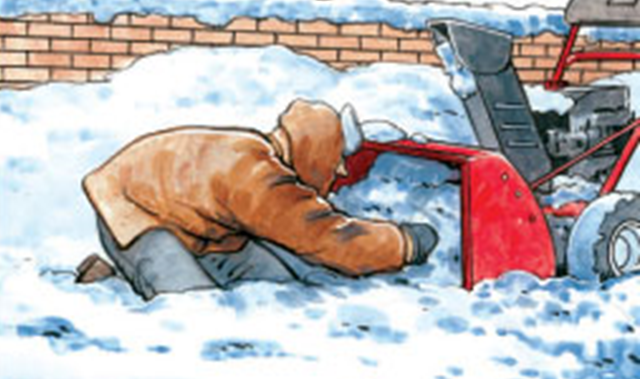
What should this worker be using to clear the chute of his snow blower’

Snow-covered sidewalks, parking lots and other outdoor areas can pose slip and fall hazards for workers and visitors to your workplace. So you should require workers to clear these areas of snow and ice. But if you have workers use snow blowers for this task, make sure they know how to safely use this equipment, especially if it should become clogged.
The illustration shows a worker in a precarious position, with his hand inside the chute of his snow blower. Should the blades begin to rotate, the worker’s hand could get caught and mangled’and he could even lose fingers or the whole hand.
For example, Prince Edward Island’s WCB recently released a hazard alert on snow blower use after an experienced worker sustained a serious hand injury when he reached inside a snow blower’s chute to try to clear an obstruction. The equipment’s power was still on and the safety system interlock hadn’t been maintained as per manufacturer’s recommendations.
Here are some snow blower dos and don’ts for workers from the government of Yukon.
DO:
- Ensure you understand the functions and operation of the machine, how to operate all controls and how to stop it in an emergency
- Wear appropriate winter garments, sturdy footwear, safety glasses, hearing protection and protective gloves while operating the snow blower
- Place appropriate signage in the area to alert traffic and pedestrians of the work in progress
- Ensure the equipment has been recently/seasonally serviced and suitably equipped’that is, check fluid levels, tire condition and that all protective devices are in place and working properly
- Maneuver equipment slowly, using sure footing and well away from uneven terrain, such as drops and embankments
- Take extra care while operating on inclines and gravel surfaces
- Remain alert for any unexpected hazards
- Fuel equipment while it’s turned off, cool to the touch and in a well-ventilated area
- Clear the device of snow and ice after use to minimize wear and damage to the moving parts.
DON’T:
- Wear loose clothing or anything that may become entangled in moving parts
- Use your hands to remove materials from the chute or blade area’use a shovel, stick, pole or tool designed for that purpose
- Smoke while fueling equipment
- Overload the machine capacity by attempting to clear snow at too fast a rate
- Park the snow blower in such a manner that it could tip and fall over
- Use the snow blower if you feel it’s too large or powerful for you to use safely
- Blow snow towards people, buildings or vehicles.
